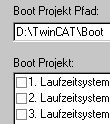Operating response for practice
TwinCAT is "suitable for practical applications"
Against a background of more than ten years of experience with PC software solutions for the PLC and the NC and more than ten thousand installations under DOS, Beckhoff has placed value on a proven and practically suitable behavior of TwinCAT. Thus, a series of characteristics is available which, in total, ensures that this software solution can be used to completely substitute a hardware solution. Many of its properties are self-evident and indispensable for users and it is particularly for this reason that users must be sure that these features are also available in software solutions.
Start / stop response

Depending on the setting, TwinCAT starts and stops by manual operation or automatically. As TwinCAT is integrated as a service in NT, no operator is needed for starting it suffices to activate the power.
The PLC can be stopped
- manually,
- automatically when Windows NT is stopped or
- by user programs.

For data backup reasons and to ensure correct termination of Windows NT, it is advisable to use a UPS (uninterruptible power supply) with a short backup time of a few minutes to shut down the PC control.
Restart with program

Just like a conventional programmable controller, TwinCAT can load and start programs after restart. These programs ("boot programs") are started before user programs to ensure that they always find an initialized and operable PLC and NC controller. It goes without saying that programs can also be loaded via a network.
Remanent data

With the boot programs, remanent (persistent) data can be loaded automatically on restart. This data is automatically backed up to the hard disk when the system has stopped. The programming environment supports easy use of remanent data at the click of a mouse or with a key word for a variable.
System status by flag
The TwinCAT severs for PLC and NC have system flags to represent and query their status (restart or number of PLC cycles etc.), which can be used for system control and to program startup behaviour.
System statuses are documented in the event logger

The system status and all status and error messages are documented in the Windows NT event display. Thanks to TwinCAT integration in Windows NT, access to these is easily possible using NT management tools.
Cycle time and system load

The execution times of the programs on a PC are set with the programming system, thus achieving a defined operating response. The TwinCAT system displays the system load for executed programs. A load limit can be set to ensure that a defined computing capacity is available for the operator control programs and Windows NT. A system message is generated if this limit is exceeded.
TwinCAT continues to operate even after user profile changes
The Windows NT user can change while the TwinCAT servers are operating, thus ensuring that operators and service personnel have different access to programming systems and maintenance programs. TwinCAT integration permits user management with the Windows NT mechanisms and security standard.
TwinCAT support system analysis

Thanks to large-scale integration of components and more than adequate performance of the processors, the PC architecture fundamentally offers a platform that is suitable for general automation tasks. On suitable hardware, stable real time and Windows NT operation can be guaranteed. The price for the openness of the PC world, however, is that this criterion must be checked when using hardware (example: graphics cards) or drivers. This restriction does not apply to Windows or TwinCAT, but to all operating systems. Owing to the use of unallowed methods, unsuitable hardware and software can cause problems for the operating system. Therefore, all operating systems restrict the installation of critical (kernel mode) drivers. Beckhoff integrates a practical display of real time jitter into its product to provide an administrator with a simple means of evaluating hardware and software. During operation, a system message can draw attention to error states.